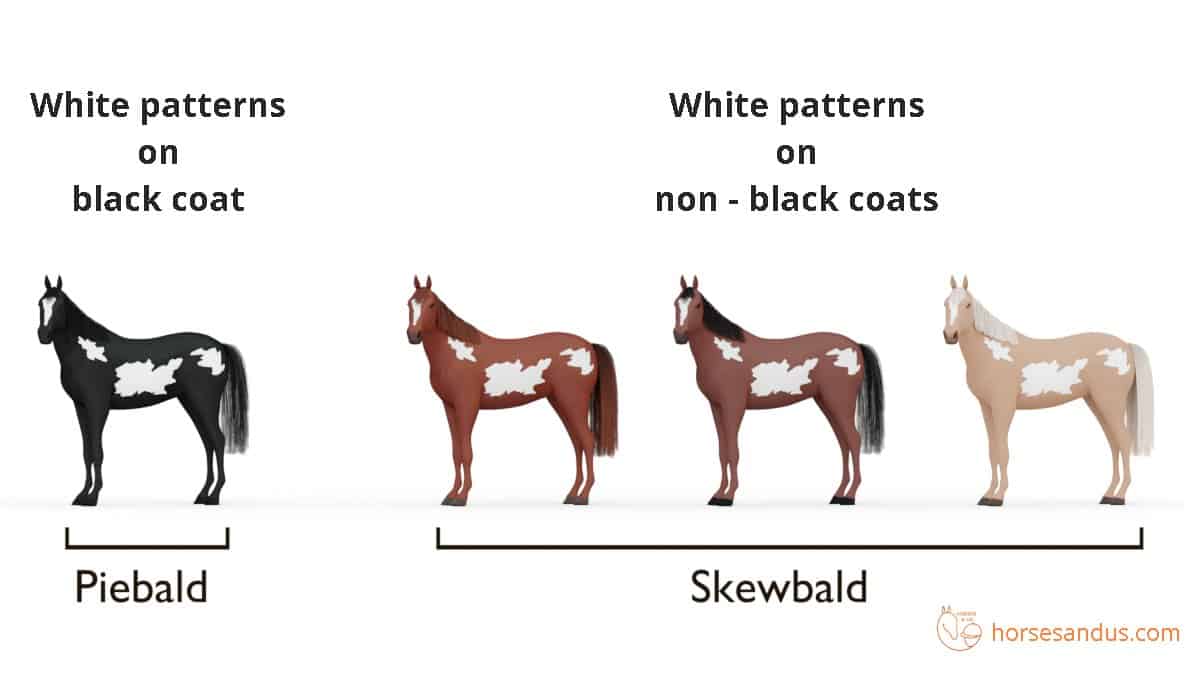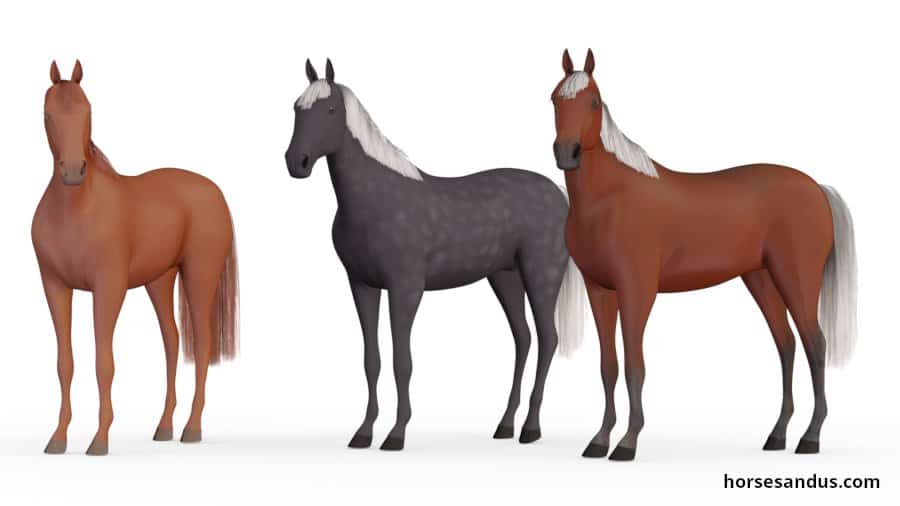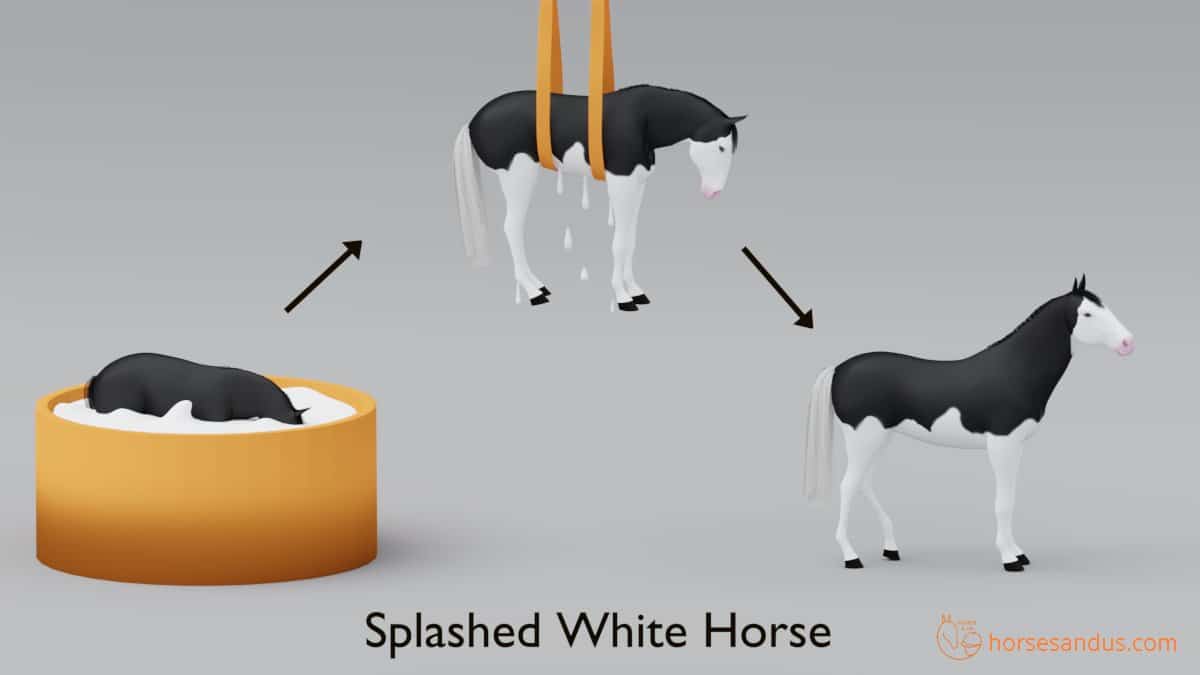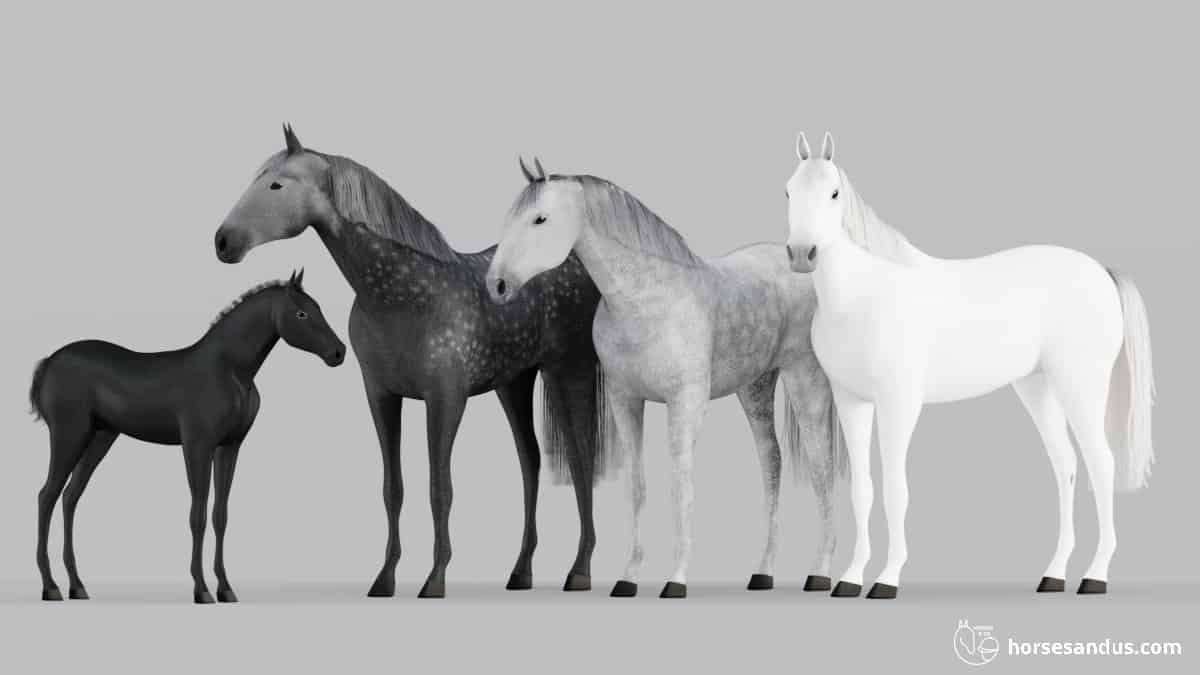A common question about white-spotted horses is, “ What is the difference between a Paint Horse and a Pinto Horse ?” The answer is actually quite simple.
While both Paint and Pinto horses are characterized by white spotting on their coat, they are not the same thing. A Paint Horse (American Paint Horse) is a breed of spotted horses limited to specific bloodlines. On the other hand, a Pinto horse is a spotted horse of any breed.
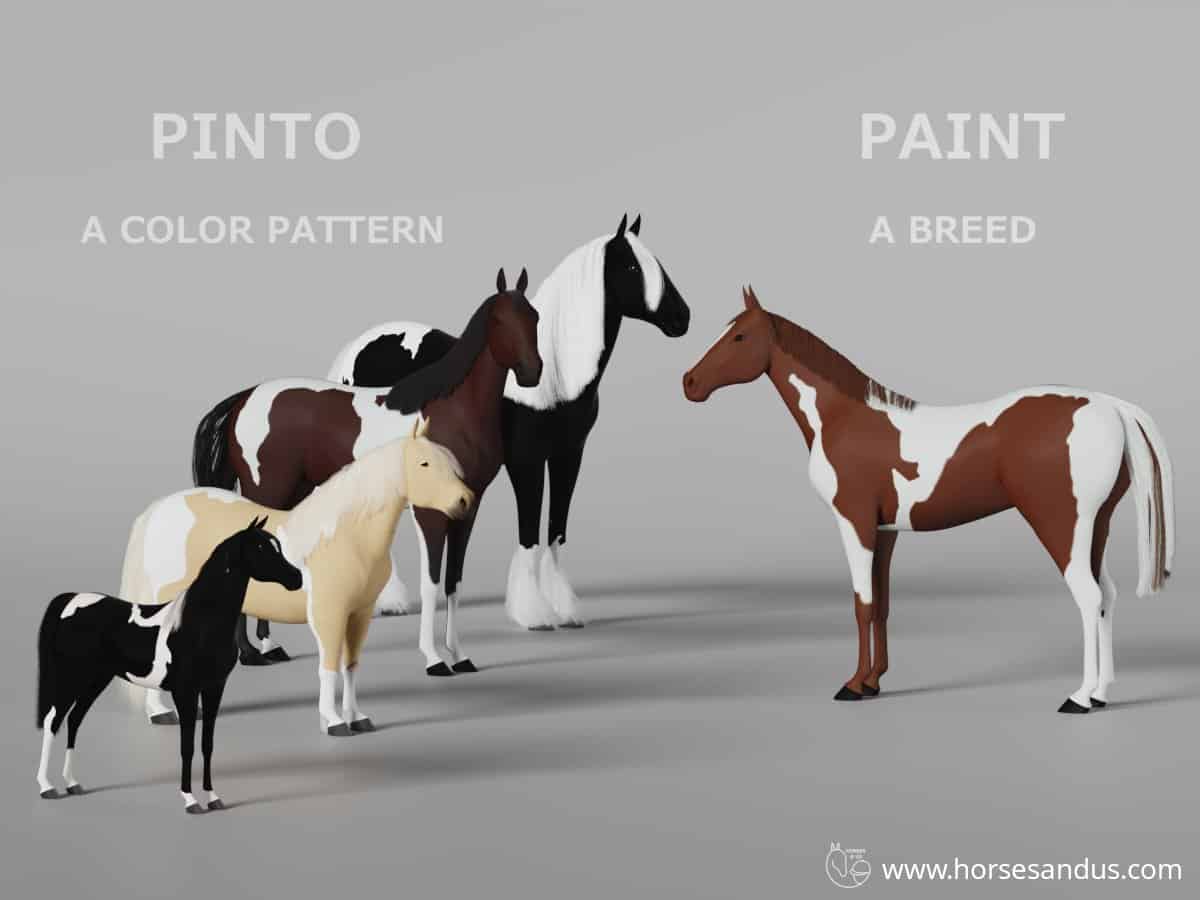
A Paint is always a Pinto, but a Pinto may not be a Paint if it belongs to another breed (other than the American Paint horse).
There is a wide variety of horse coat colors and patterns. In this article, we will look specifically at Pinto and Paint horses which are characterized by white patterns.
Pinto Vs. Paint Comparison Chart
Similarities and Differences
| Pinto | Paint | |
|---|---|---|
| Breed | It is not a breed but instead a Color Pattern (color breed) | Is a breed |
| Bloodlines | Any bloodline from any breed | Limited to Paint, Quarter and Thoroughbred bloodlines |
| Color Pattern | Tobiano, Overo, Splashed White, Sabino, dominant white, or any combination of these. Excludes Leopard Complex Pattern. | Tobiano, Overo, Splashed White, Sabino, dominant white, or any combination of these. Excludes Leopard Complex Pattern. |
| Solid Color Allowed | Yes, but it can only be registered in the Solid Registry under certain conditions. | Yes, but it can only be registered as Solid-Paint Bred under certain conditions. |
| Conformation | Stock-type conformation | It has no consistent conformation but can be classified into 8 different types |
| Origin date | At least 4th Century BC | 16th century |
What Qualifies a Horse as a Pinto?
A Pinto is a spotted horse from any breed (including Paint).
Pinto refers to a coat color, not a breed. However, it can be considered a color breed whose registration is based on coat color, independently of the horse´s actual breed.
PtHA
Horses with the Pinto type pattern are registered at the Pinto Horse Association of America (PtHA).
Any horse from any breed or crossbreed can be registered as long as their white spotting meets the Pinto pattern requirements.
Not all horses with white spotting are considered Pinto. The leopard Complex white spotting, characteristic of the Appaloosa, is not considered a Pinto. In the past, it was not allowed to be registered. However, since 2019 it is accepted in the Solid Registry.
This association organizes competitive events to showcase horses with the Pinto pattern.
Pinto Horse Color Pattern
The Pinto horse coat color pattern is the same as the Paint horse, characterized by white spots over a colored coat. The underlying color of the coat can be one of the base colors chestnut, black, or bay or a diluted color such as Palomino, Buckskin (or any other cream dilution), Dun, Champagne, or Silver.
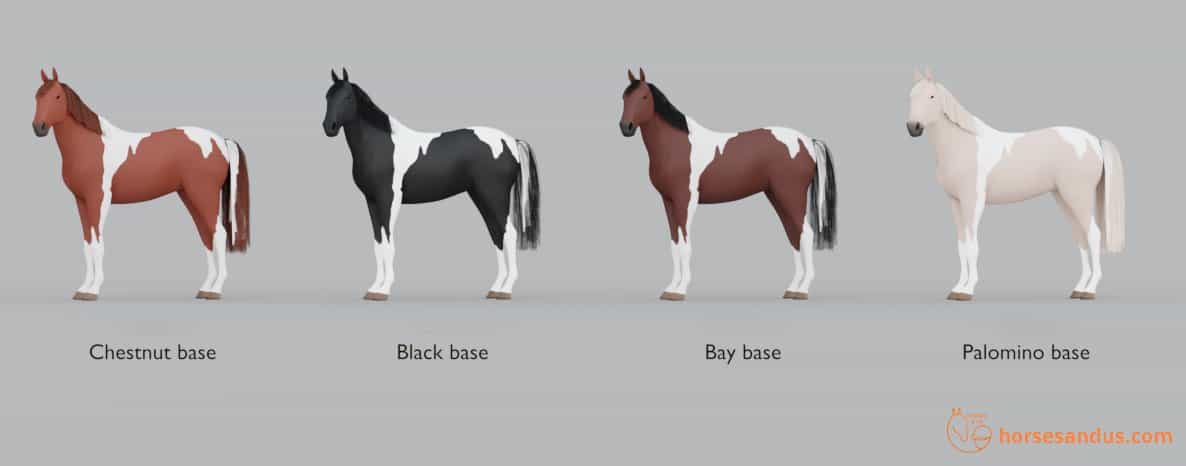
The white spots can have different shapes and sizes but cannot belong to the Leopard Complex patterns (characteristic of the Appaloosa).
The spotting patterns of a Pinto horse are Frame Overo, Tobiano, Sabino, Splashed White, and Dominant White or any combination of these like, for example, the Tovero.
Pinto Horse Color Requirements
A Pinto horse should have at least one contrasting area of solid white hair, which can vary in size depending on the type of horse.
- 2 square inches for miniatures
- 3 square inches for ponies
- 4 square inches for all other horse types
Horses that do not meet these color requirements cannot be registered in the Color Registry. However, they can be registered in the Solid Registry under the following conditions:
- Have at least two or more pinto characteristics (blue eyes, white spotting above the knee or hock, or multicolored hooves.)
- Registered in an approved outcross registry.
Pinto Horse Conformation
The Pinto horse does not have a consistent conformation because it is bred for its color pattern.
However, there are 8 types of conformation defined for Pinto horses, depending on the different breeds’ conformation.
These types are listed below with examples of the predominant breeds associated to each group.
| Conformation Type | Predominant Breeds/Traits |
|---|---|
| Stock | Horses- Quarter and Paint Ponies- Shetland pony |
| Hunter | Horses- Thoroughbred and approved European Warmblood Ponies – Connemara pony |
| Pleasure | Horses – Arabian, Andalusian, and/or Morgan Ponies – Welsh pony |
| Saddle | Horses – Saddle, Hackney, or Tennessee Walking Horse Ponies – Hackney ponies |
| Mini A | Miniature horse – measuring less than 35 inches at the withers |
| Mini B | Miniature horse – measuring between 35 and 39 inches at the withers |
| Gypsy | Gypsy Cob or Vanner |
| Drum | Gypsy crossbreeding with other draft breeds or full blood draft type breeds |
Pinto Horse Breeds
Any breed of horse can be registered as a Pinto as long as it meets the color pattern requirements.
Horses that do not have the color pattern requirements may still be registered in the solid registry under certain conditions.
Origins of the Pinto Horse
Many people associate the Pinto Horse with the American West and Native Indians. However, this is only the recent history of the Pinto horse. The original spotted horses existed much earlier in other parts of the world.
The origins of Pinto horses can be traced back to ancient times. Evidence of their existence has been found in Egyptian tombs dating back to the 4th century B.C.
Pinto horses were used in the Mongol Empire for the conquest of Asia during the 13th and 14th centuries
European art of the 16th, 17th, and 18th centuries has many paintings of Pinto horses.
Spanish Explorers brought these colored horses to America during the 16th and 17th centuries. These horses were the ancestors of the American Pinto.
The word “pinto” comes from “pintado” which is a Spanish/Portuguese word meaning “painted”.
Source: https://www.pinto.org/index.php/en/association/about-us/history-of-the-breed
What Qualifies a Horse as a Paint?
The Paint Horse, or more correctly American Paint Horse, is a breed that combines two characteristics:
- A coat with the Pinto White Pattern.
- Bloodlines limited to Paint, Quarter Horse, and Thoroughbred.
APHA
The American Paint Horse breed is managed by the American Paint Horse Association (APHA).
In order for a horse to be registered as an American Paint Horse, it must meet both bloodline and white pattern requirements defined by the APHA.
However, non-spotted horses can be registered as Solid Paint-Bred, if both parents are registered Paints by the APHA.
Paint Horse Color Pattern
Paint horses have the Pinto pattern, i.e., white spots over a colored coat. The underlying color of the coat can be one of the base colors chestnut, black, or bay. But it can also be a diluted color such as Palomino, Buckskin (or any other cream dilution), Dun, Champagne, or Silver. Paints can also carry the Grey gene.
The white spots can have different shapes and sizes typical of the Pinto spotting. However, the white pattern cannot belong to the Leopard Complex patterns (characteristic of the Appaloosa).
The spotting patterns of the Paint horse are the typical pinto patterns, i.e., Frame Overo, Tobiano, Sabino, Splashed White, and Dominant White or any combination of these like, for example, the Tovero.
Paint Horse Color Requirements
Per the APHA rules, a paint horse must have the “ natural paint marking” in order to qualify for the regular registry.
The “natural paint marking” can have 2 variations:
- A horse with a predominantly colored coat should have at least one contrasting area (2” or more) of solid white hair with underlying unpigmented skin (present at birth) within the green highlighted zone in the picture below.
- A horse with a predominantly white coat should have at least one contrasting area (2” or more) of colored hair with underlying pigmented skin (present at birth) within the green highlighted zone in the picture below.
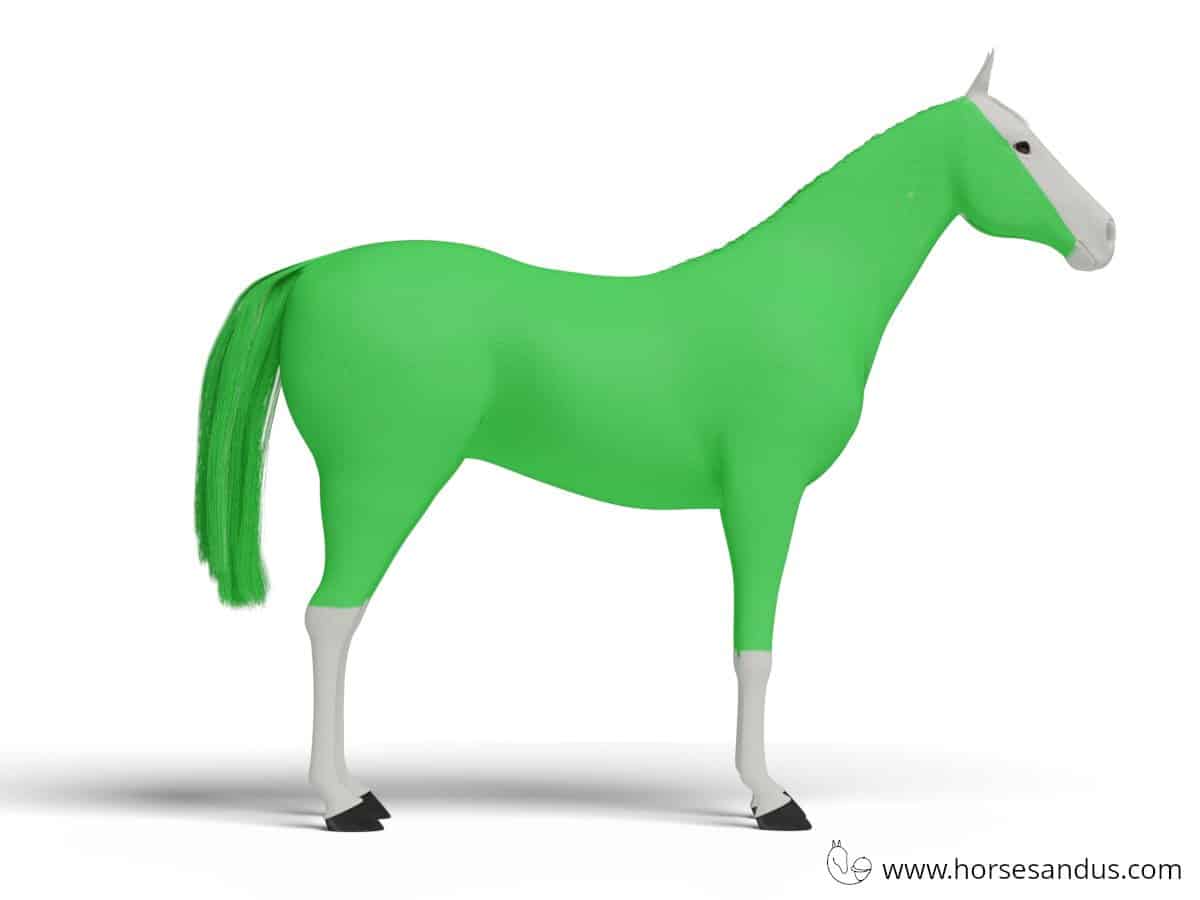
The Leopard Complex Patterns (characteristic of the Appaloosa) are not allowed in the Regular Registry, even if they have the natural paint markings mentioned above.
Paint Horse Conformation
The American Paint horse is between 14 and 16 hands tall. The horses belonging to the thoroughbred bloodlines are typically the taller ones.
It has a “stock type” conformation, well-muscled with powerful hindquarters, compact and agile.
Origins of the Paint Horse
The Paint horse is a descendent of the horses brought to North America by the Spanish explorers around 1500. These horses came from North Africa (Barb), Iberian Peninsula (Andalusian), and Asia Minor (Arabian).
Cowboys and Indians appreciated the paint horses
Many were left roaming in the wild and ended up being captured by cowboys and Native Americans.
The cowboys appreciated them for their cattle work and their hardiness to walk hundreds of miles.
The Native Americans liked them as war horses because they believed these horses possessed magical powers due to their coloring. Native Americans also painted themselves for battles believing this provided them with magical protection.
The traits were improved leading to the Paint Horse of Today
Over time, the conformation and athletic ability of these horses were improved, creating the American Paint horse we know today.
Paint horses have the same “stock horse” body type as the Quarter horse, and until 1940 they shared the same gene pool and were registered as American Quarter horses. But then, they were excluded because of their white pattern.
Horse Associations were formed
However, they remained very popular, leading to the formation of the American Paint Quarter Horses Association and the American stock horse Association. In 1965 these two associations joined together to form the American Paint Horse Association APHA that we know today.
sources: imh and afs.okstate.edu
Suggestions for Paint Horse Gifts
If you are an admirer of the Paint Horse or have a friend who is, we suggest the following gift ideas:
The links below that lead to a product on Amazon are affiliate links and I earn a commission (with no additional cost for you) if you make a purchase.
Piebald and Skewbald
Piebald and Skewbald are both terms often used to describe Pinto and Paint horses.
Piebald is a spotted horse with a black base color
Skewbald is a spotted horse with any base color other than black, such as chestnut, bay, palomino, buckskin, dun, and so on.
